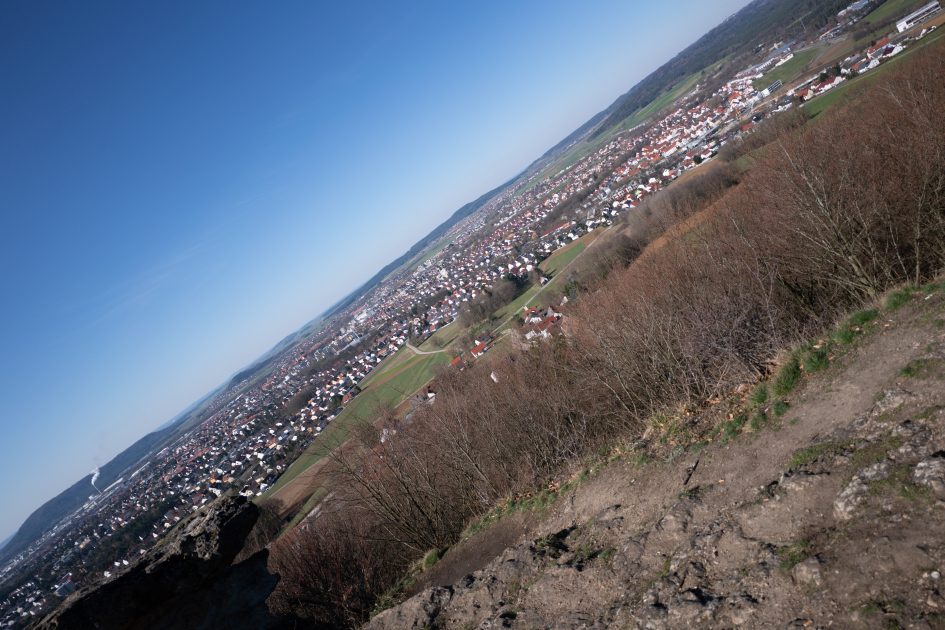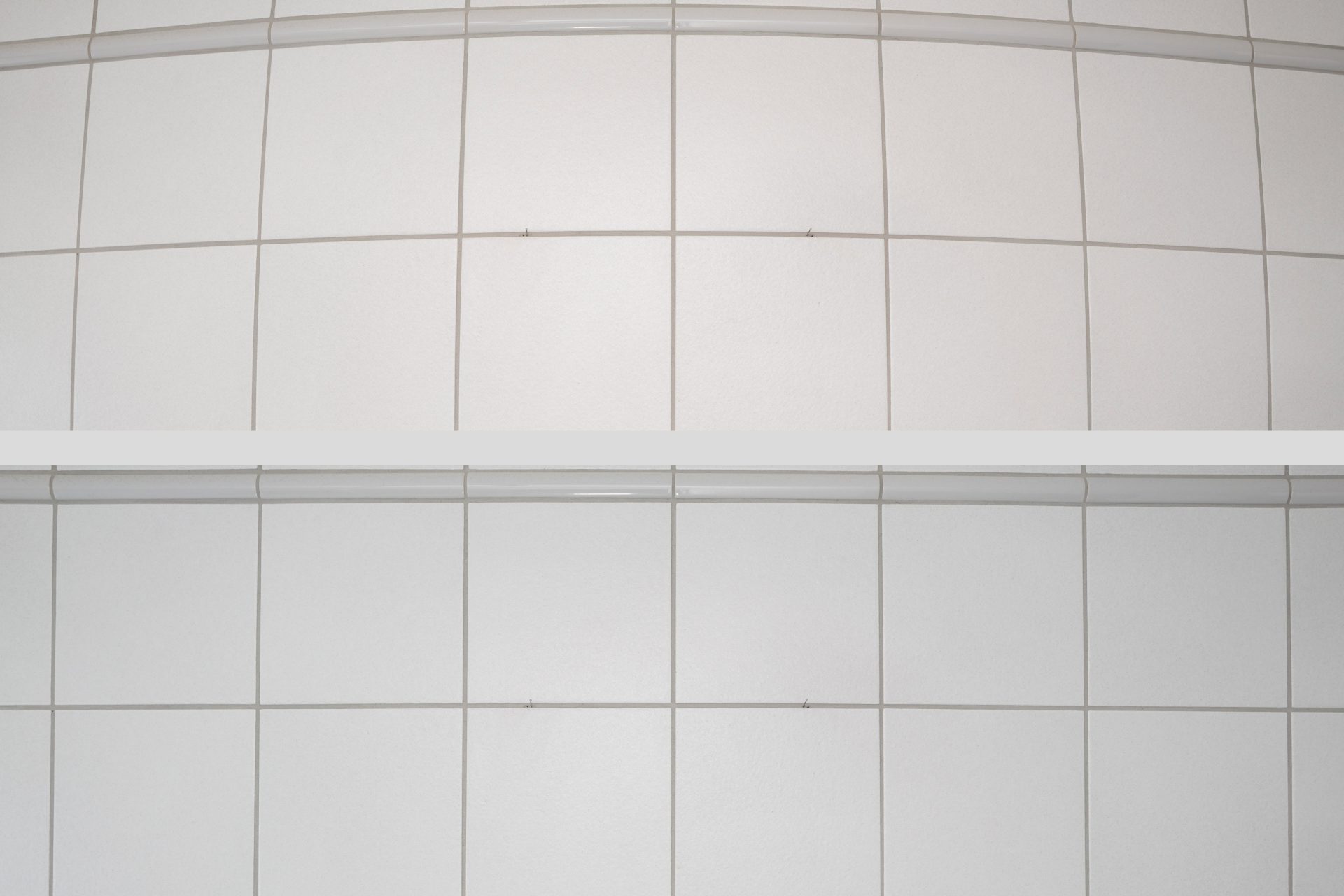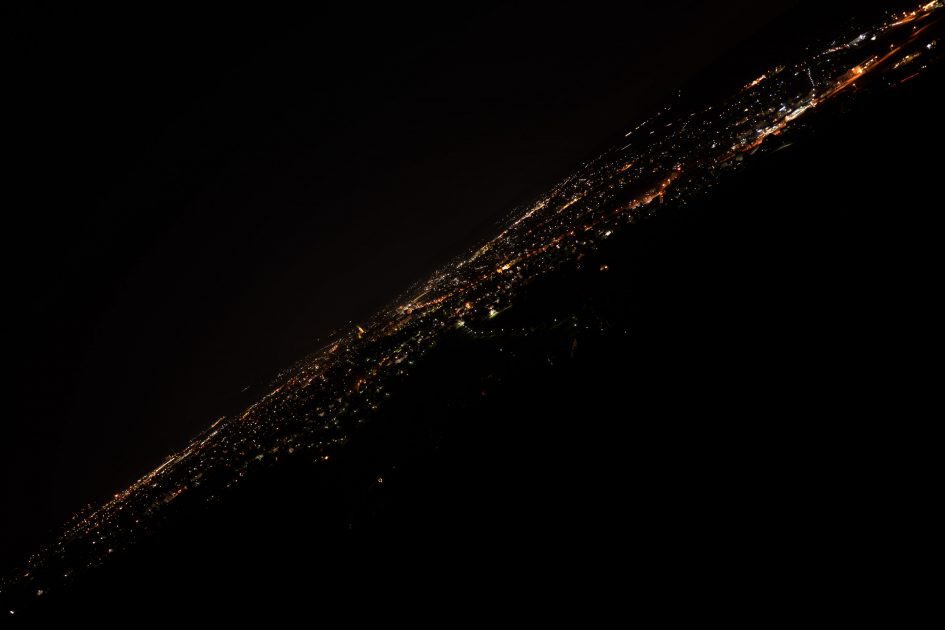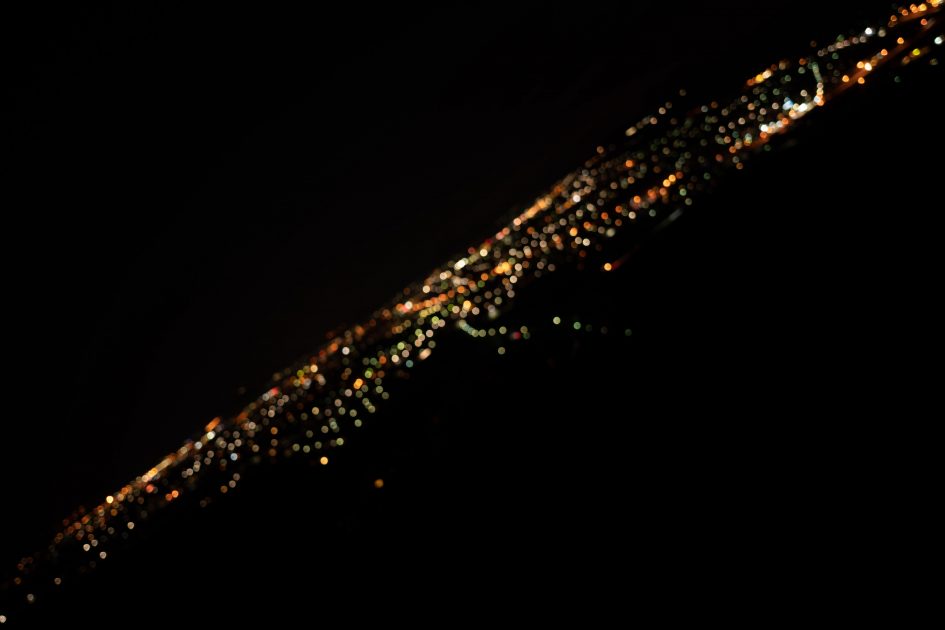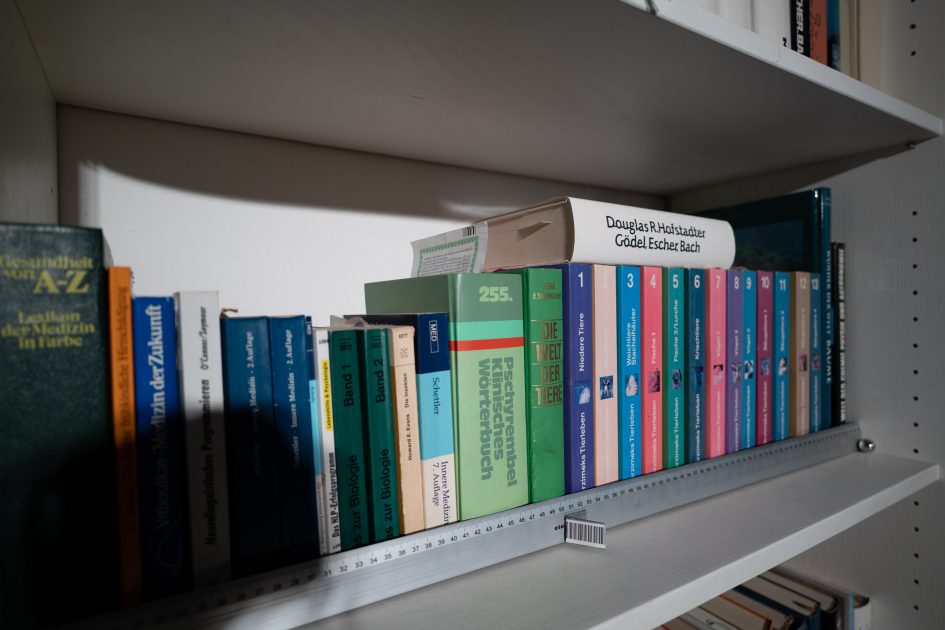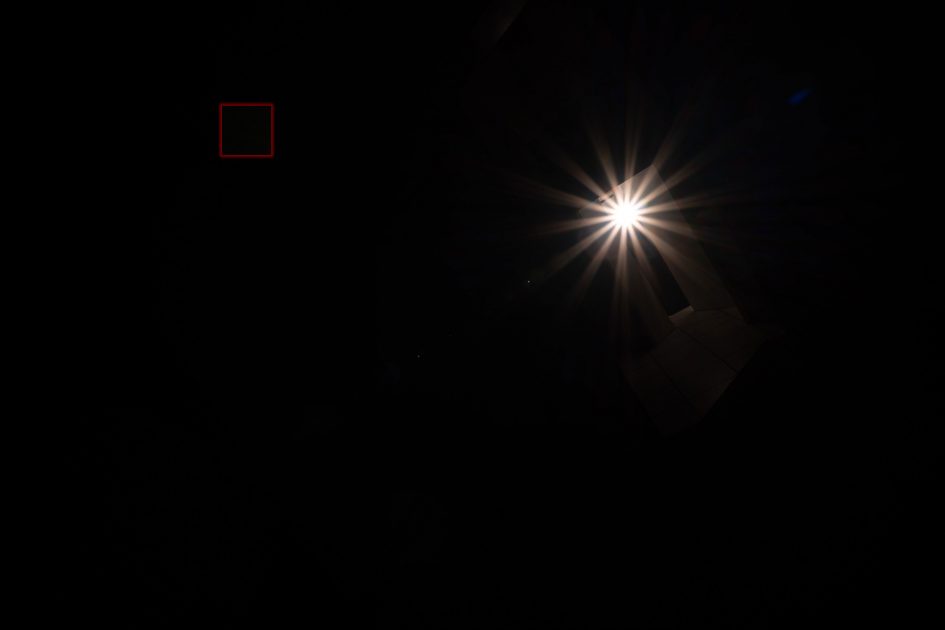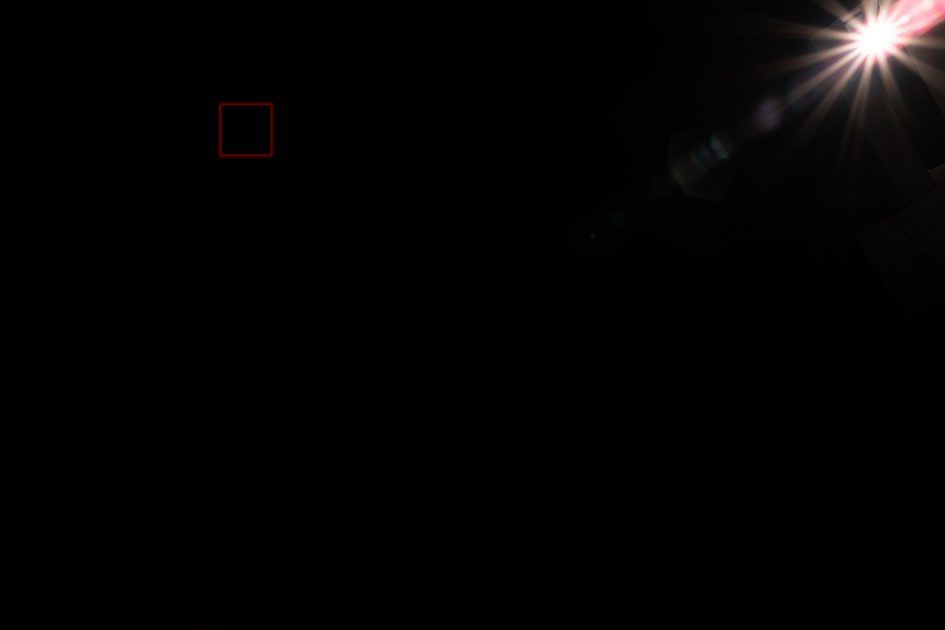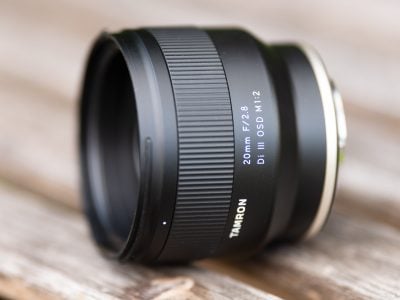Tamron 20mm f2.8 Di III M1:2 review
-
-
Written by Thomas
Quality
Testing: Longitudinal Chromatic Aberration and focus shift
Lenses with focal ratios of f2.8 or larger are often prone to longitudinal color aberrations (loCA, a.k.a. “axial color” or “bokeh CA”). These show up as magenta coloration in the foreground and greenish hues in the background and are not easily corrected in post-processing. The new Tamron has some loCA at f2.8 but not overly so:
Tamron 20mm f2.8 M1:2 Longitudinal Chromatic Aberration (loCA)
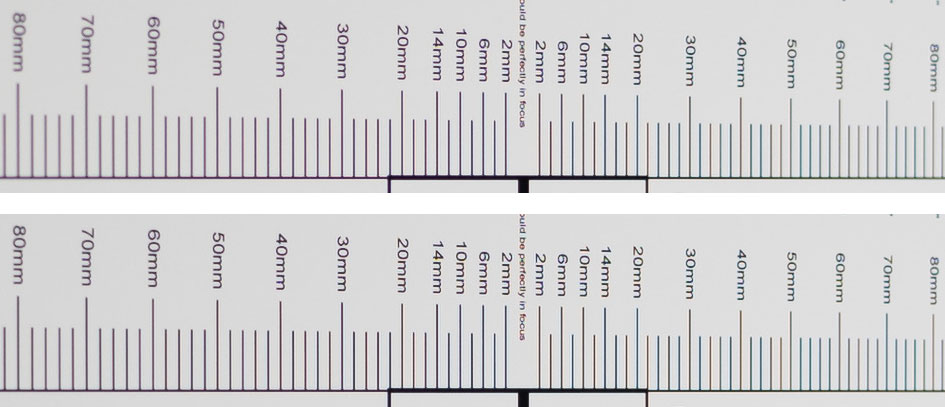
Above: 100% crops, f2.8 (top), f4.0 (bottom); left = foreground, right = background
The test also showed no focus shift to speak of at distances of 1m and farther away. For comparison have a look at the Sony FE 20mm f1.8 G shown at f1.8 and f2.8.
The following real life shot shows that the Tamron 20mm f2.8 M1:2 produces only little purple fringing around high-contrast edges but some green outlining around background subjects:
Above: Tamron 20mm f2.8 M1:2 at f2.8; 100% crop; click image to access 4k version
Sharpness and contrast
Let’s have a look at the theoretical performance of the new Tamron 20mm f2.8 M1:2 first and compare it to the performance of the Nikon 20mm f1.8G and two f1.4 alternatives from Sigma and Nikon:
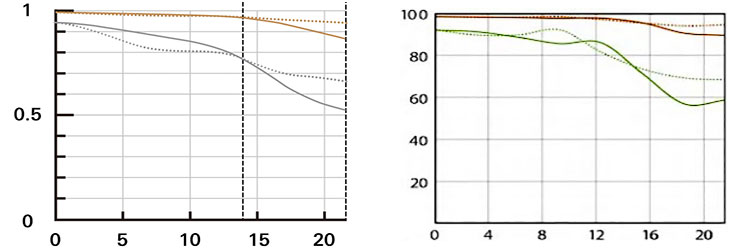
Above: MTF Tamron 20mm f2.8 M1:2 (left) at f2.8, Sony 20mm f1.8 G (right) at f1.8
These MTF charts show the computed lens-performance wide open without influence of diffraction. Higher values are better (more contrast) and the closer the solid and dotted lines are together the less astigmatism (= resolution depends on the orientation of the test-pattern) the lens has. The x-axis displays the distance from the optical axis (=center of the sensor) in mm. I’ll show you the real-life performance at 4 mm (center), 13 mm (APS-C-corner), and 20 mm (FF-corner) on a 42MP Sony A7R II body.
From the charts the new Tamron 20mm f2.8 M1:2 should produce a very contrasty image across the sensor with pretty sharp details within the APS-C image-circle. The Sony in comparison looks very similar but keep in mind that it is shown at f1.8 here, whereas the Tamron is at f2.8. Stopping the Sony down to f2.8 should improve its performance well above the Tamron.
Let’s see how this theoretical performance of Tamron’s new lens translates into real life results in the sharpness test based on Siemens-stars. The following images were taken with the 42MP Sony A7R II camera with lens profile in camera set to Auto. The images are RAW files developed in Lightroom 9.2/CRAW 12.2 to Adobe Color profile, Noise Reduction=OFF, sharpening=50/0.5/36/10. At the time of writing the Adobe RAW converter did not recognize the Distortion Control built into the lens so I activated the lens profile which Adobe supplies with Vignette Control set to 0 and Distortion Control set to 93. This best resembles the JPGs straight out of camera. White-balance was adjusted to a neutral white and I did some exposure compensation to make the brightness of all crops match. So you will not see light fall-off in the corners. No extra tone, color, or saturation adjustment were applied.
The following 100% crops show the Tamron 20mm f2.8 M1:2 from f2.8 down to f11 compared to the Sony FE 20mm f1.8 G and the Tamron 17-28mm f2.8 Di III at 20mm, f2.8.
Tamron 20mm f2.8 M1:2; 100% crop from center, APS-C-corner, FF-corner

Above: Tamron 20mm f2.8 M1:2 at f2.8

Above: Sony FE 20mm f1.8 G at f2.8; also available at f1.8, f2.0, f4.0, f5.6, f8.0, f11

Above: Tamron 17-28mm f2.8 Di III at 20mm f2.8; also available at 20mm f4.0, f5.6, f8.0, f11
The Tamron 20mm f2.8 M1:2 produces a very sharp center with slightly softer APS-C-corners. The Sony is clearly the sharpest lens of the three with both Tamron lenses slightly softer within the APS-C image-circle. In the FF-corner the Tamron 20mm f2.8 M1:2 even falls behind the Tamron 17-28mm f2.8 Di III zoom lens.
Now let’s see how the new Tamron develops when stopped further down:

Above: Tamron 20mm f2.8 M1:2 at f4.0

Above: Tamron 20mm f2.8 M1:2 at f5.6

Above: Tamron 20mm f2.8 M1:2 at f8.0

Above: Tamron 20mm f2.8 M1:2 at f11
Stopping down to f4.0 lifts the APS-C-corner a bit but the FF-corner stays soft from astigmatism well up to f11. Btw.: The Tamron 20mm f2.8 M1:2 shows practically no field curvature.
Performance at long distances
The Siemens-star test-targets are shot at a distance of 45x focal length (i.e. at around 0.9m for 20mm focal length). But performance of lenses also depends on the shooting distance. Therefore I present another series of test-shots of a city around 1 km away. The following images were taken with the 42MP Sony A7R II camera with lens profile in camera set to Auto. The images are RAW files developed in Lightroom 9.2/CRAW 12.2 to Adobe Color profile, Noise Reduction=OFF, sharpening=50/0.5/36/10. The Adobe lens profile was applied with Vignette Control set to 0 and Distortion Control set to 93 to best resemble JPGs straight out of camera. Otherwise I only did the occasional exposure compensation in post-processing but no extra tone, color, or saturation adjustment. I used autofocus at the largest aperture and did not change focus for other apertures. All shots were made at ISO 100 and image stabilization switched off. As usual I have selected the diagonal that provided the better corner results as the Tamron 20mm f2.8 M1:2 was slightly decentered.
The main image shows the complete scene wide open to give you an impression of the angle of view (after applying distortion control) and to judge vignetting of the Tamron 20mm f2.8 M1:2. Following the main image are 100% crops from the center, APS-C-corner, and FF-corner down to f11 compared to the Sony FE 20mm f1.8 at f2.8 and the Tamron 17-28mm f2.8 Di III at 20mm, f2.8. While both prime lenses were shot only minutes apart, the Tamron zoom was shot another day but under similar atmospheric conditions.
You can access the large originals via the supplied links. Please respect our copyright and only use those images for personal use.
Above: Tamron 20mm f2.8 M1:2 at f1.8; click image for 4k version, large original available at f2.8, f4.0, f5.6, f8.0, f11
Above: Tamron 20mm f2.8 M1:2 at f2.8
Above: Sony FE 20mm f1.8 at f2.8; click image for 4k version, large original available at f1.8, f2.0, f2.8, f4.0, f5.6, f8.0, f11

Above: Tamron 17-28mm f2.8 Di III at 20mm f2.8; click image for 4k version, large original available at 20mm f2.8, f4.0, f5.6, f8.0, f11
In this long-distance shot the Tamron 20mm f2.8 M1:2 convinces with a very sharp center and a pretty good full-frame corner. But the APS-C-corner is soft especially compared to the Sony FE 20mm f1.8 G. Even the Tamron zoom looks slightly better than the Tamron 20mm f2.8 M1:2 outside the center.
This is how the new Tamron develops when stopped further down:
Above: Tamron 20mm f2.8 M1:2 at f4.0
Above: Tamron 20mm f2.8 M1:2 at f5.6
Above: Tamron 20mm f2.8 M1:2 at f8.0
Above: Tamron 20mm f2.8 M1:2 at f11
Stopping the Tamron 20mm f2.8 M1:2 down to f5.6 lifts the softening veil from the APS-C-corner and renders a pretty sharp image across the full frame. Still, the lens cannot match the performance of the Sony FE 20mm f1.8 at f2.8.
Vignetting and distortions
To make it easier to see light fall-off in the corners of a full-frame sensor I’ve arranged a series of three shots with the Tamron 20mm f2.8 M1:2 at different apertures. All images were developed to the same brightness in the center and only Distortion Control (set to 93) from the Adobe lens profile applied in the first row of images. The second row was in addition treated with +50 Vignette Control from Lightroom which lifts the extreme corners by about 1 EV at f2.8:
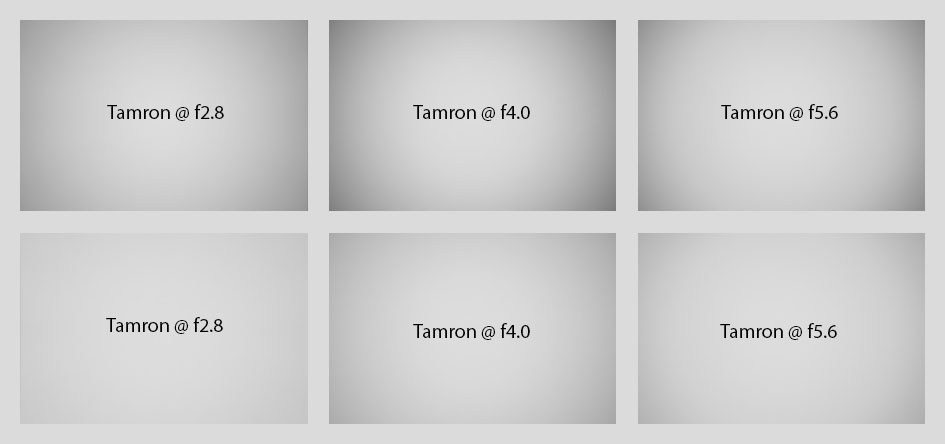
Above: Tamron 20mm f2.8 M1:2 at f2.8, f4.0, f5.6
The strange thing is that stopping down from f2.8 to f4.0 introduces heavier vignetting. This also shows in JPGs straight out of camera.
Regarding distortions: The new Tamron 20mm f2.8 M1:2 shows very strong barrel distortions which are not corrected in Adobe’s RAW converter unless you switch on Adobe’s lens profile with Distortion Control set to 93. This best resembles the JPGs straight out of camera (bottom half):
Above: Distortions of Tamron 20mm f2.8 M1:2, Auto Distortion Control Off/On
Due to the strong “stretching” of the pixels in the corner from the distortion correction there is a slight loss of corner sharpness in the process. And as the distortion correction is not visible in the viewfinder of the Sony A7R II it is a bit of guesswork where exactly objects near the full-frame corners will land in the corrected image.
Rendering of point-light sources at night-shots
Night-shots pose a different challenge for lenses as the contrast is even higher than under bright sun and point-light sources can reveal some weaknesses such as coma, haloing and colour-aberrations that do not show up as prominently in other test-shots. The 100% crops below the main image show the effect of coma in the FF-corner at various apertures:
Above: Tamron 20mm f2.8 M1:2 at f2.8; click image for 4k version, large original available at f2.8, f4.0, f5.6, f8.0
Above: Tamron 20mm f2.8 M1:2; 100% crops from the FF-corner at f2.8 left, f4.0 (middle), f5.6 (right)
Sony FE 20mm f1.8 G; 100% crops from the FF-corner at f1.8 (left), f2.8 (middle), f4.0 (right)

Above: Tamron 17-28mm f2.8 Di III at 17mm; 100% crops from the FF-corner at f2.8 (left), f4.0 (middle), f5.6 (right)
The Tamron 20mm f2.8 M1:2 shows some coma at f2.8 and f4.0 while coma of the Sony FE 20mm f1.8 G is practically nonexistent at f2.8. The Tamron zoom also shows only little coma.
Rendering of out-of-focus point-light sources
This test is for the rendering of point-light sources in an out-of-focus background. The circle of confusion that is produced by this test is pretty indicative of Bokeh performance (in the background) and light fall-off. Ideally the out-of-focus image of the point-light is evenly lit and perfectly circular, with no “onion-rings”, and without coloration. Large aperture lenses normally produce an effect known as “cat’s eye” the further away from the optical axis the point-light is projected. This is due to optical vignetting in the lens barrel when light enters the lens from an angle.
The 46% crops below the main image show the Bokeh balls at the center, APS-C-corner, and FF-corner at the largest aperture from the Tamron and the Sony:
Above: Tamron 20mm f2.8 M1:2 at f1.8; click image for 4k version, large original available at f2.8, f4.0, f5.6, f8.0
Above: Tamron 20mm f2.8 M1:2 at f2.8; 46% crops from center, APS-C-corner, FF-corner
Above: Sony FE 20mm f1.8 G at f1.8; 46% crops from center, APS-C-corner, FF-corner; large original available at f1.8, f2.0, f2.8, f4.0, f5.6, f8.0
The Tamron 20mm f2.8 M1:2 suffers from its smaller focal ratio, stronger onion rings and more pronounced outlining when compared to the Sony FE 20mm f1.8 G.
Let’s see how this analysis of out-of-focus point-light sources translates into Bokeh-performance shooting a book-shelf compared to the Sony FE 20mm f1.8 G and the Tamron 17-28mm f2.8 Di III.
Above: Tamron 20mm f2.8 M1:2 at f2.8; click image for 4k version, large original available at f2.8, f4.0, f5.6, f8.0
Above: Tamron 20mm f2.8 M1:2 at f1.8; 46% crops from foreground, middle-ground, background
Above: Sony FE 20mm f1.8 G at f1.8; 46% crops from foreground, middle-ground, background; large original available at f1.8, f2.0, f2.8, f4.0, f5.6, f8.0

Above: Tamron 17-28mm f2.8 Di III at 28mm, f2.8; 46% crops from foreground, middle-ground, background; large original available at f2.8, f4.0, f5.6, f8.0
Again the Sony FE 20mm f1.8 G pulls ahead of the Tamron prime lens due to its f1.8 focal ratio: It renders the out-of-focus areas softer with a smooth transition in the middle-ground. The Tamron 17-28mm f2.8 Di III also has a slight benefit over the Tamron 20mm f2.8 M1:2 as it is shown here at its longest focal length of 28mm which makes for a 40% larger entrance pupil at f2.8. But the Tamron zoom lens cannot fully profit from this as it suffers from outlining producing double contours. This makes hard contrast edges in the background look nervous and not very soft.
Close-up performance
The Tamron 20mm f2.8 M1:2 goes down to 1:2 magnification. Its performance in the center is very usable even at f2.8. But the lens is soft at the APS-C-corner and outright mushy further outside even at f8.0. The following image was shot at 1:2 magnification where the area of sharp focus is just 48 x 72mm. The crops shown below are from 0mm, 12mm, and 18mm off the center of the sensor respectively:

Above: Tamron 20mm f2.8 M1:2 at f2.8, 1:2 magnification; 100% crops

Above: Tamron 20mm f2.8 M1:2 at f4.0, 1:2 magnification; 100% crops

Above: Tamron 20mm f2.8 M1:2 at f8.0, 1:2 magnification; 100% crops
Trying to improve off-center performance by focusing specifically for the cropped areas did not improve performance much. So results are not significantly influenced by field-curvature.
Let’s see whether performance improves at a lower magnification of 1:4 where the area of sharp focus is 96 x 144mm. The crops shown below are from 2mm, 12mm, and 18mm off the center of the sensor respectively:

Above: Tamron 20mm f2.8 M1:2 at f2.8, 1:4 magnification; 100% crops

Above: Tamron 20mm f2.8 M1:2 at f4.0, 1:4 magnification; 100% crops

Above: Tamron 20mm f2.8 M1:2 at f8.0, 1:4 magnification; 100% crops
The Tamron is now sharper than at 1:2 magnification but still needs stopping down to f8.0 if you want usable result towards the borders. This may not be a problem if you don’t shoot flat objects.
The Sony FE 20mm f1.8G is much sharper outside the center than the Tamron 20mm f2.8 M1:2 at a comparable magnification of 1:4.2. The following crops are from 0mm, 12mm, and 18mm off the center of the sensor respectively.

Above: Sony FE 20mm f1.8 G at f4.0, 1:4.2 magnification; 100% crops
Flare, ghosting, and sun-stars
Catching a strong light-source shining directly into the lens is always a risky business: it could produce strange colourful ghost-images or reduce contrast considerably through flare and glare. The appearance of flare and ghosting depends on factors like the aperture and the angle of the light hitting the lens. So to judge the proclivity of the new Tamron 20mm f2.8 M1:2 for these artefacts I went through a series of well calculated shots against a strong light source to provoke glare and ghosting. The lens hood was mounted in all shots. See two examples at f11 where these effects normally show up most prominently. The little bright square inset in the upper left shows the respective area with an exposure compensation of +3 EV to make it easier to see which levels of black the lens renders at that point:
Above: Flare and ghosting. Strong light hitting the Tamron 20mm f2.8 M1:2 at f11; click image for 4k version or here for +3 EV exposure compensation
Above: Flare and ghosting. Strong light hitting the Tamron 20mm f2.8 M1:2 at f11; click image for 4k version or here for +3 EV exposure compensation
The Tamron 20mm f2.8 M1:2 is very clear of flare and ghosting artefacts. And outside these artefacts the new lens renders a very deep black, so there’s little veiling glare. But the lens produces a bright flare when the light-source is near the corner. Fortunately the flare is directed towards the corner and not across the sensor. So it’s only mildly annoying.
All-in-all the Tamron 20mm f2.8 M1:2 let’s you shoot confidently under adverse contra-light situations. To produce nice sunstars the lens needs to be stopped down to f8.0.

Above: Sunstars from the Tamron 20mm f2.8 M1:2 at f5.6 (left) and f8.0 (right), 100% crop
Next check out my sample images!
Check prices on the Tamron 20mm f2.8 Di III M1:2 at Amazon, B&H, Adorama or Wex. Alternatively get yourself a copy of my In Camera book or treat me to a coffee! Thanks!
